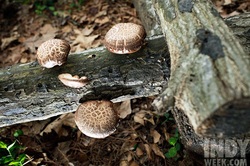- Home
- Mushrooms - why?
- Chaga mushroom - medicinal
- Red reishi - medicinal
- Chicken mushroom – food
- Puffballs - food
- Maitake mushroom - medicinal
- Chanterelle mushroom - food
- Lobster mushrooms - food
- Honey mushrooms -food
- Shiitake mushroom – medicinal and food
- Morels - food
- Oyster Mushrooms - medicinal and food
- Common poisonous mushrooms in NC
- How to grow oyster mushrooms at home
- Blog
Shiitake mushrooms

Spring is best for these
Shiitake mushrooms are one of the handfuls of mushrooms that can be cultivated on a commercial scale. They are cultivated using trees or wood as
a growing medium. Both natural log and sawdust log cultivation are used in small and large scale productions. Natural log cultivation is the oldest method and imitates nature closely. The logs are 100% recyclable; once the logs are
exhausted of nutritional benefits, they can be used for composting or as a natural fertilizer.
Shiitake mushrooms, pronounced shee-TAH-kay, range in colors from amber to paper bag-brown. Each mushroom has a wide, umbrella shape with a characteristic curled rim. Their caps, growing up to eight inches in diameter, have a cream-colored interior described as supple-firm. When cooked, shiitakes
release a garlic-pine aroma and have a rich, earthy, umami flavor.
In addition to their culinary uses, Shiitake mushrooms have long been used for medicinal purposes in both raw and dried form. They are rich in vitamins and minerals with potently high levels of vitamin B2, B12 and vitamin D. Shiitakes are a source of the compound Lentinan, which is being evaluated as an anti-cancer drug.
Shiitake mushrooms are widely used in Asian cuisine. They are not limited to Asian recipes and although they are a cultivated variety, they may be substituted in recipes calling for "wild mushrooms". Pair Shiitake with Asian mustard greens, eggplant, rice, noodles, garlic, soy and Chile. May be sautéed, roasted or skewered and grilled.
Shiitake mushrooms are one of the handfuls of mushrooms that can be cultivated on a commercial scale. They are cultivated using trees or wood as
a growing medium. Both natural log and sawdust log cultivation are used in small and large scale productions. Natural log cultivation is the oldest method and imitates nature closely. The logs are 100% recyclable; once the logs are
exhausted of nutritional benefits, they can be used for composting or as a natural fertilizer.
Shiitake mushrooms, pronounced shee-TAH-kay, range in colors from amber to paper bag-brown. Each mushroom has a wide, umbrella shape with a characteristic curled rim. Their caps, growing up to eight inches in diameter, have a cream-colored interior described as supple-firm. When cooked, shiitakes
release a garlic-pine aroma and have a rich, earthy, umami flavor.
In addition to their culinary uses, Shiitake mushrooms have long been used for medicinal purposes in both raw and dried form. They are rich in vitamins and minerals with potently high levels of vitamin B2, B12 and vitamin D. Shiitakes are a source of the compound Lentinan, which is being evaluated as an anti-cancer drug.
Shiitake mushrooms are widely used in Asian cuisine. They are not limited to Asian recipes and although they are a cultivated variety, they may be substituted in recipes calling for "wild mushrooms". Pair Shiitake with Asian mustard greens, eggplant, rice, noodles, garlic, soy and Chile. May be sautéed, roasted or skewered and grilled.
